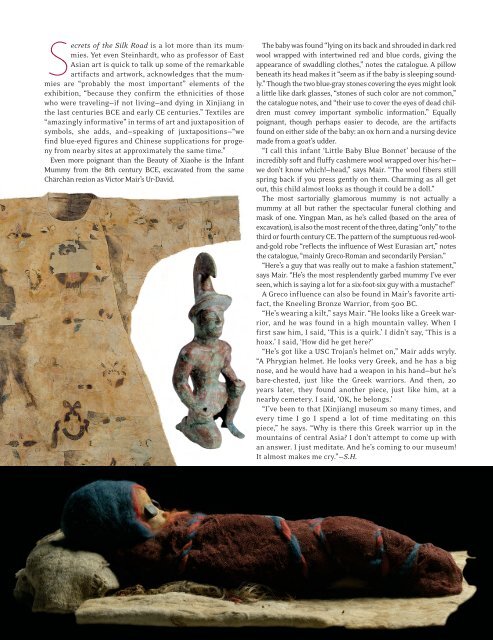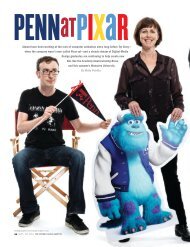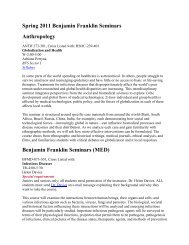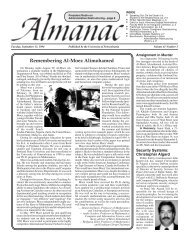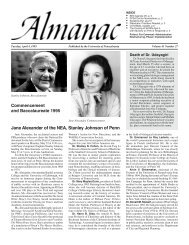Download this article (PDF) - University of Pennsylvania
Download this article (PDF) - University of Pennsylvania
Download this article (PDF) - University of Pennsylvania
Create successful ePaper yourself
Turn your PDF publications into a flip-book with our unique Google optimized e-Paper software.
Secrets <strong>of</strong> the Silk Road is a lot more than its mummies.<br />
Yet even Steinhardt, who as pr<strong>of</strong>essor <strong>of</strong> East<br />
Asian art is quick to talk up some <strong>of</strong> the remarkable<br />
artifacts and artwork, acknowledges that the mummies<br />
are “probably the most important” elements <strong>of</strong> the<br />
exhibition, “because they confirm the ethnicities <strong>of</strong> those<br />
who were traveling—if not living—and dying in Xinjiang in<br />
the last centuries BCE and early CE centuries.” Textiles are<br />
“amazingly informative” in terms <strong>of</strong> art and juxtaposition <strong>of</strong><br />
symbols, she adds, and—speaking <strong>of</strong> juxtapositions—“we<br />
find blue-eyed figures and Chinese supplications for progeny<br />
from nearby sites at approximately the same time.”<br />
Even more poignant than the Beauty <strong>of</strong> Xiaohe is the Infant<br />
Mummy from the 8th century BCE, excavated from the same<br />
Chärchän region as Victor Mair’s Ur-David.<br />
The baby was found “lying on its back and shrouded in dark red<br />
wool wrapped with intertwined red and blue cords, giving the<br />
appearance <strong>of</strong> swaddling clothes,” notes the catalogue. A pillow<br />
beneath its head makes it “seem as if the baby is sleeping soundly.”<br />
Though the two blue-gray stones covering the eyes might look<br />
a little like dark glasses, “stones <strong>of</strong> such color are not common,”<br />
the catalogue notes, and “their use to cover the eyes <strong>of</strong> dead children<br />
must convey important symbolic information.” Equally<br />
poignant, though perhaps easier to decode, are the artifacts<br />
found on either side <strong>of</strong> the baby: an ox horn and a nursing device<br />
made from a goat’s udder.<br />
“I call <strong>this</strong> infant ‘Little Baby Blue Bonnet’ because <strong>of</strong> the<br />
incredibly s<strong>of</strong>t and fluffy cashmere wool wrapped over his/her—<br />
we don’t know which!—head,” says Mair. “The wool fibers still<br />
spring back if you press gently on them. Charming as all get<br />
out, <strong>this</strong> child almost looks as though it could be a doll.”<br />
The most sartorially glamorous mummy is not actually a<br />
mummy at all but rather the spectacular funeral clothing and<br />
mask <strong>of</strong> one. Yingpan Man, as he’s called (based on the area <strong>of</strong><br />
excavation), is also the most recent <strong>of</strong> the three, dating “only” to the<br />
third or fourth century CE. The pattern <strong>of</strong> the sumptuous red-wooland-gold<br />
robe “reflects the influence <strong>of</strong> West Eurasian art,” notes<br />
the catalogue, “mainly Greco-Roman and secondarily Persian.”<br />
“Here’s a guy that was really out to make a fashion statement,”<br />
says Mair. “He’s the most resplendently garbed mummy I’ve ever<br />
seen, which is saying a lot for a six-foot-six guy with a mustache!”<br />
A Greco influence can also be found in Mair’s favorite artifact,<br />
the Kneeling Bronze Warrior, from 500 BC.<br />
“He’s wearing a kilt,” says Mair. “He looks like a Greek warrior,<br />
and he was found in a high mountain valley. When I<br />
first saw him, I said, ‘This is a quirk.’ I didn’t say, ‘This is a<br />
hoax.’ I said, ‘How did he get here?’<br />
“He’s got like a USC Trojan’s helmet on,” Mair adds wryly.<br />
“A Phrygian helmet. He looks very Greek, and he has a big<br />
nose, and he would have had a weapon in his hand—but he’s<br />
bare-chested, just like the Greek warriors. And then, 20<br />
years later, they found another piece, just like him, at a<br />
nearby cemetery. I said, ‘OK, he belongs.’<br />
“I’ve been to that [Xinjiang] museum so many times, and<br />
every time I go I spend a lot <strong>of</strong> time meditating on <strong>this</strong><br />
piece,” he says. “Why is there <strong>this</strong> Greek warrior up in the<br />
mountains <strong>of</strong> central Asia? I don’t attempt to come up with<br />
an answer. I just meditate. And he’s coming to our museum!<br />
It almost makes me cry.”—S.H.<br />
THE PENNSYLVANIA GAZETTE JAN | FEB 2011 47


